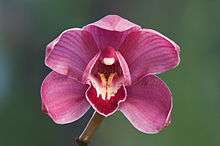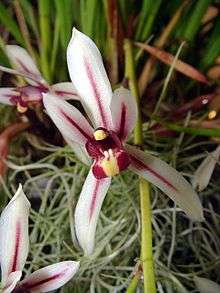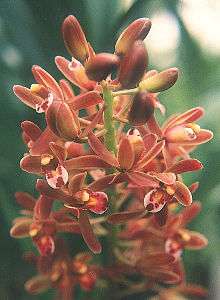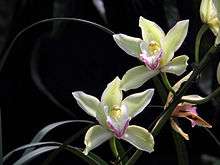Cymbidium
- For the brachiopod genus, see Cymbidium (brachiopod).
| Boat orchids | |
|---|---|
| | |
| Cymbidium Clarisse Austin 'Best Pink' | |
| Scientific classification | |
| Kingdom: | Plantae |
| (unranked): | Angiosperms |
| (unranked): | Monocots |
| Order: | Asparagales |
| Family: | Orchidaceae |
| Subfamily: | Epidendroideae |
| Tribe: | Cymbidieae |
| Subtribe: | Cymbidiinae |
| Genus: | Cymbidium Swartz |
| Species | |
|
See text.(over 60 species) | |
| Synonyms | |
| |




(Cymbidium floribundum)
Cymbidium /sɪmˈbɪdiəm/,[1] or boat orchid, is a genus of 52 evergreen species in the orchid family Orchidaceae. The new Latin genus name is derived from the Latin cymba meaning boat. Its first known use was in 1815.[2]
Distribution
This genus is distributed in tropical and subtropical Asia (such as northern India, China, Japan, Malaysia, the Philippines, and Borneo) and northern Australia. The larger flowered species from which the large flowered hybrids are derived grow at high altitudes.[3]
Culinary usage
The species Cymbidium hookerianum is considered a delicacy in Bhutan where it is traditionally cooked in a spicy curry or stew and called "olatshe" or "olachoto".[4][5][6] It is sometimes confused with Cyclanthera pedata, another local delicacy (the nomenclature has not been clearly established; there are indications that "olatshe" usually refers to Cymb. and "olachoto" to Cycl., although not consistently).
Growth
Cymbidium plants are sympodial and grow to a height of 60 cm and the racemes as high as 90 cm. The raceme grows from the base of the most recent pseudobulb. Each flower can have a diameter of 5 to 10 cm, according to the species. They bloom during the winter, and each plant can have up to fifteen or more flowers. The fantastic range of colors for this genus include white, green, yellowish-green, cream, yellow, brown, pink, and red [and orange] and black (and there may be markings of other color shades at the same time), but not blue. The flowers last about ten weeks. They have a waxy texture. The rounded sepals and petals have about the same dimensions.
There are fragrant varieties as well, notably the Chinese cymbidiums. They have been cultivated for thousands of years, especially in China. Cymbidiums became popular in Europe during the Victorian era. One feature that makes the plant so popular is the fact that it can survive during cold temperatures (as low as 7˚ C or 45˚ F) [Actually they will survive at temperatures below 32˚F for short periods and even as low as 28˚F].
Species





- Cymbidium aestivum (Yunnan, China South-Central)
- Cymbidium aliciae (Philippines)
- Cymbidium aloifolium: Aloe-Leafed Cymbidium (Himalaya to W. Malaysia)
- Cymbidium atropurpureum (S. Thailand, W. & C. Malaysia)
- Cymbidium bicolor: Two-Colored Cymbidium (S. China to Trop. Asia)
- Cymbidium bicolor subsp. bicolor (S. India, Sri Lanka) Pseudobulb epiphyte
- Cymbidium bicolor subsp. obtusum (Himalaya to S. China and Indo-China). Pseudobulb epiphyte
- Cymbidium bicolor subsp. pubescens (W. & C. Malaysia)
- Cymbidium borneense (N. & NW. Borneo)
- Cymbidium canaliculatum: Banana Orchid, Queensland Black Orchid, Small Groove-leaf Cymbidium (N. & E. Australia)
- Cymbidium chawalongense (newly discovered in Tibet)
- Cymbidium chloranthum: Green-flowered Cymbidium (W. Malaysia)
- Cymbidium cochleare (E. Himalaya to Taiwan)
- Cymbidium concinnum (Yunnan, SW China)
- Cymbidium cyperifolium (Himalaya to S. China and Philippines)
- Cymbidium cyperifolium subsp. cyperifolium (Himalaya to S. China).. Pseudobulb epiphyte
- Cymbidium cyperifolium subsp. indochinense (Indo-China, Philippines). Pseudobulb epiphyte
- Cymbidium dayanum: Phoenix Orchid, Tree Orchid, Day's Cymbidium (Himalaya to S. Japan and Malaysia)
- Cymbidium defoliatum (China)
- Cymbidium devonianum: Devon's Cymbidium (Nepal to N. Thailand)
- Cymbidium eburneum: Ivory-colored Cymbidium (Himalaya to Hainan)
- Cymbidium elongatum (NW. Borneo)
- Cymbidium elegans (SW China)
- Cymbidium ensifolium: Four Season Orchid, Golden-thread Orchid, Spring Orchid, Burned Apex Orchid, Rock Orchid (Trop. & Temp. E. Asia)
- Cymbidium ensifolium subsp. ensifolium: Mt. Tu-Wu Fall Orchid (Indo-China to Temp. E. Asia). Pseudobulb, epiphyte
- Cymbidium ensifolium subsp. haematodes (S. India to New Guinea). Pseudobulb epiphyte
- Cymbidium erythraeum: Indian Cymbidium (Himalaya to SC. China)
- Cymbidium erythrostylum: Red Column Cymbidium (Vietnam)
- Cymbidium faberi: Multi-flower Orchid, Miscanthus Orchid (Uttaranchal to Taiwan)
- Cymbidium faberi var. faberi (C. & S. China, Taiwan). Pseudobulb epiphyte
- Cymbidium faberi var. szechuanicum (Uttaranchal to SC. China). Pseudobulb epiphyte
- Cymbidium finlaysonianum: Finlayson's Cymbidium (Indo-China to Malaysia)
- Cymbidium flavum (China)
- Cymbidium floribundum: Golden Leaf-edge Orchid, Golden-edged Orchid, Yellow Margin Orchid (S. China, Taiwan).
- Cymbidium goeringii: Spring Orchid (Himalaya to Temp. E. Asia).
- Cymbidium goeringii subsp. goeringii : Goering's Cymbidium (Himalaya to Temp. E. Asia). Pseudobulb epiphyte
- Cymbidium goeringii subsp. goeringii var. goeringii: Chinese Spring Orchid, Japanese Spring Orchid, Korean Spring Orchid (Temp. E. Asia) Pseudobulb epiphyte
- Cymbidium goeringii subsp. goeringii var. formosanum: Taiwanese Spring Orchid (Taiwan) Pseudobulb epiphyte
- Cymbidium goeringii subsp. goeringii var. forrestii: Yunnanese Spring Orchid, Pseudobulb epiphyte
- Cymbidium goeringii subsp. gracillimum : Leek Orchid, Chive Orchid (Japan to S. China). Pseudobulb epiphyte
- Cymbidium goeringii subsp. longibracteatum (SC. China). Pseudobulb epiphyte
- Cymbidium goeringii subsp. longibracteatum var. longibracteatum Sword-leaf Spring Orchid (SC. China). Pseudobulb epiphyte
- Cymbidium goeringii subsp. longibracteatum var. tsukengensis Mt. Tsukerg Orchid, Snow Orchid (SC. China). Pseudobulb epiphyte
- Cymbidium goeringii subsp. tortisepalum : Broad-leaf Spring Orchid (SC. China to Taiwan) Pseudobulb epiphyte
- Cymbidium goeringii subsp. tortisepalum var. tortisepalum (Taiwan). Pseudobulb epiphyte
- Cymbidium goeringii subsp. tortisepalum var. lianpan Miscanthus Orchid (SC. China). Pseudobulb epiphyte
- Cymbidium goeringii subsp. goeringii : Goering's Cymbidium (Himalaya to Temp. E. Asia). Pseudobulb epiphyte
- Cymbidium gongshanense (S. China)
- Cymbidium hartinahianum J.B.Comber & Nasution 1977 (N. Sumatra)
- Cymbidium hookerianum (E. Nepal to S. China).
- Cymbidium insigne: Splendid Cymbidium (N. Thailand to Hainan)
- Cymbidium iridioides: Iris-like Cymbidium (Himalaya to SC. China)
- Cymbidium kanran: Cold-growing Cymbidium (S. China to S. Japan)
- Cymbidium lancifolium: Green-flowered Peacock Orchid, Lance-leafed Cymbidium (Trop. & Subtrop. Asia)
- Cymbidium lancifolium var. lancifolium : Green Bamboo-leaf Orchid, Cut-grass Orchid (Trop. & Subtrop. Asia) Pseudobulb epiphyte
- Cymbidium lancifolium var. papuanum (New Guinea). Pseudobulb epiphyte
- Cymbidium longifolium (Himalaya to SC. China)
- Cymbidium lowianum: Low's Cymbidium (China to N. Indo-China)
- Cymbidium lowianum var. kalawense (Myanmar). Pseudobulb epiphyte
- Cymbidium lowianum var. lowianum (China to N. Indo-China). Pseudobulb epiphyte
- Cymbidium macrorhizon (N. Pakistan to Temp. E. Asia).
- Cymbidium madidum: Buttercup Orchid, Northern Cymbidium, Moist Forest Cymbidium (Queensland to N. New South Wales)
- Cymbidium maguanense F.Y. Liu: Ivory-colored Cymbidium (Yunnan, SW China)
- Cymbidium mastersii: Masters's Cymbidium (E. Himalaya to China)
- Cymbidium micranthum (Yunnan, China South-Central,temperate Asia)
- Cymbidium multiradicatum (Yunnan, SW China)
- Cymbidium munronianum (E. Himalaya to Assam)
- Cymbidium nanulum (China (SW. Yunnan, SW. Guizhou), Hainan)
- Cymbidium omeiense (China, Xichuan)
- Cymbidium parishii (S. Myanmar)
- Cymbidium qiubeiense (China)
- Cymbidium rectum (Malaysia, N. Borneo)
- Cymbidium roseum (W. Malaysia)
- Cymbidium sanderae: Sander's Cymbidium (Vietnam)
- Cymbidium schroederi (C. Vietnam)
- Cymbidium sigmoideum (W. Malaysia)
- Cymbidium sinense: Chinese Cymbidium (Assam to Nansei-shoto)
- Cymbidium suave: Snake Orchid (E. Australia)
- Cymbidium suavissimum (N. Myanmar)
- Cymbidium teretipetiolatum (China)
- Cymbidium tigrinum: Tiger-striped Cymbidium (Assam to China).
- Cymbidium tracyanum: Tracy's Cymbidium (SE. Tibet to China and Indo-China)
- Cymbidium wenshanense (China to Vietnam)
- Cymbidium whiteae (Sikkim)
- Cymbidium wilsonii (China)
Natural Hybrids
- Cymbidium × ballianum (= C. eburneum × C. mastersii) (Myanmar)
- Cymbidium × baoshanense (= C. lowianum × C. tigrinum) (SC. Yunnan)
- Cymbidium × chiu-lih(?) (= C. lancifolium × C. ensifolium) (China)
- Cymbidium × nishiuchianum (= C. goeringii × C. kanran) (Taiwan)
- Cymbidium × nishiuchianum (= C. goeringii subsp. goeringii var. formosanum × C. kanran) (Taiwan)
- Cymbidium × florinda (= C. erythrostylum × C. iridioides. Cyperorchis × florinda) (Vietnam)
- Cymbidium × gammieanum (= C. elegans × C. erythraeum. Cyperorchis × gammieana) (Nepal to Sikkim)
- Cymbidium × glebelandensis (= C. insigne × C. schroederi) (Vietnam)
- Cymbidium × jy-shiang(?) (= C. lancifolium × C. sinense) (China)
- Cymbidium × rosefieldense (= C. hookerianum × C. tracyanum. Cyperorchis × rosefieldensis) (Vietnam)
- Cymbidium × woodlandense (= C. mastersii × C. tracyanum. Cyperorchis × woodlandensis) (Myanmar)
Asian Cymbidium

Asian Cymbidiums or Chinese Cymbidiums refer to mainly five species of cymbidiums orchids that are found throughout East Asia in areas of China, Korea, Japan, India, and in parts of Thailand and Vietnam. These species are usually grown for their variegated leaves. But plants are also grown for their fragrant flowers and peloric flower structure. Plants are usually grown in long and thin vase like pots. The five species are:
- Cymbidium sinense
- Cymbidium ensifolium
- Cymbidium kanran
- Cymbidium goeringii (all the varieties like v. longibracteatum, v. lianpan, subsp. gracillimum are treated as different groups in the culture traditionally) Image
- Cymbidium faberi
Diseases
Cymbidiums are susceptible to the Tobacco mosaic virus and Cymbidium mosaic potexvirus.
Notes
External links
-
 Media related to Cymbidium at Wikimedia Commons
Media related to Cymbidium at Wikimedia Commons -
 Data related to Cymbidium at Wikispecies
Data related to Cymbidium at Wikispecies - Multikey System for Identification of Cymbidium species
- Cymbidium Society of America